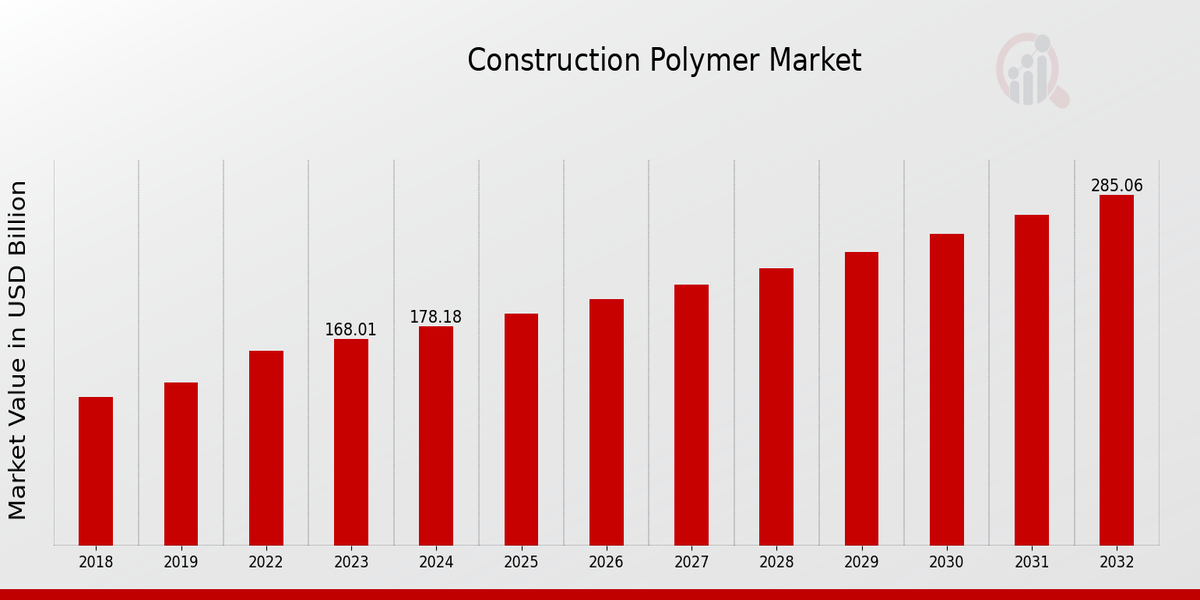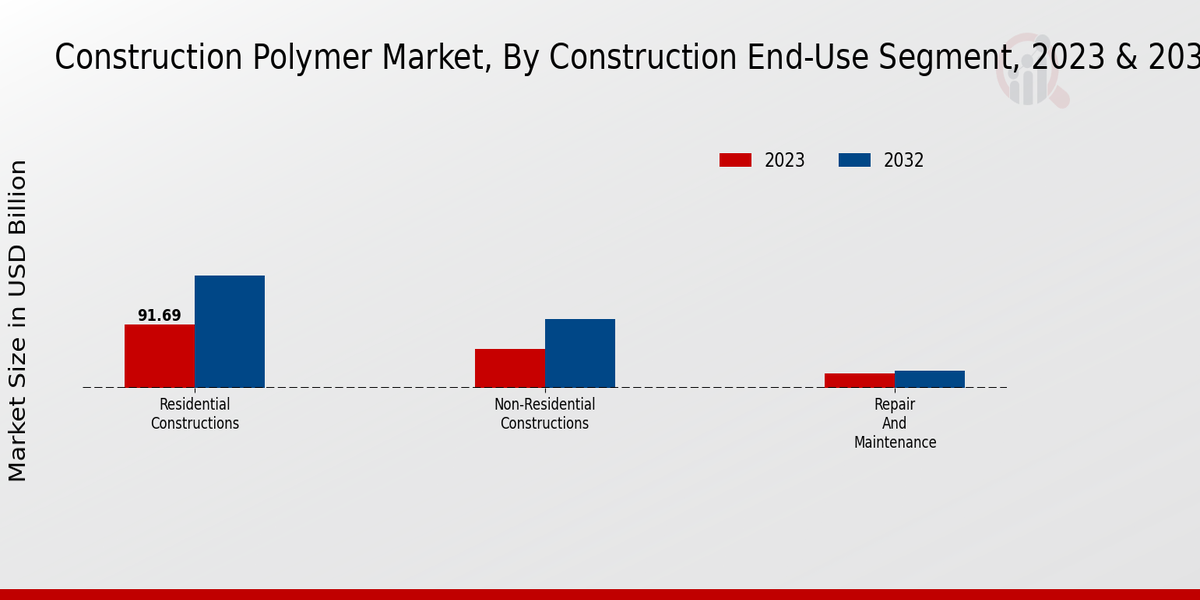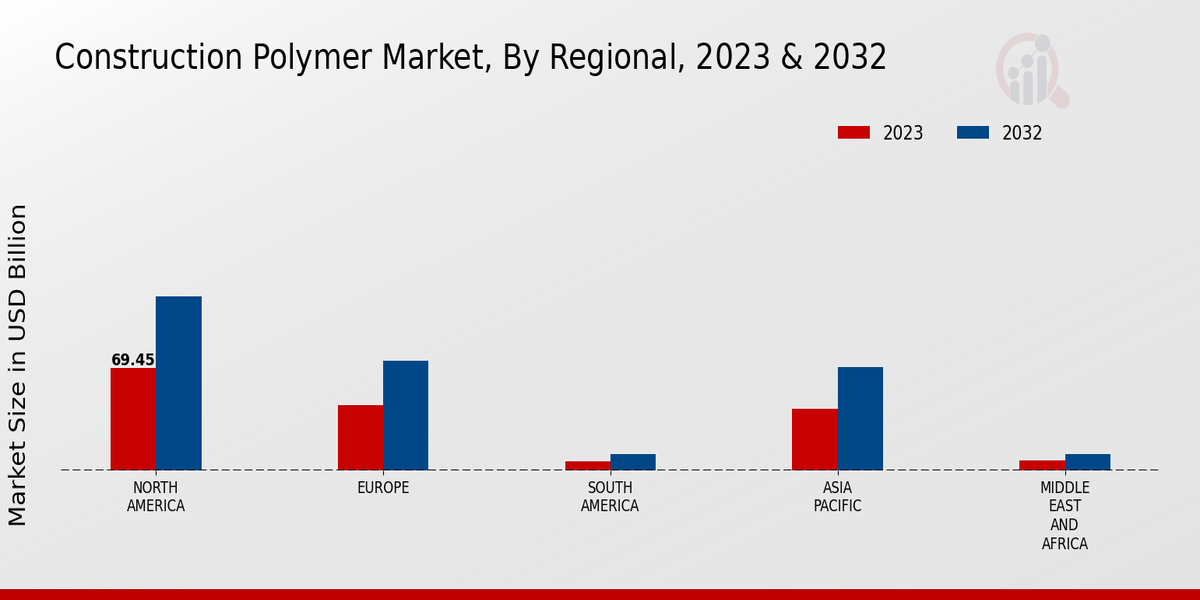Global Construction Polymer Market Overview
Construction Polymer Market Size was estimated at 188.97 (USD Billion) in 2024. The Construction Polymer Industry is expected to grow from 200.41 (USD Billion) in 2025 to 340.08 (USD Billion) by 2034. The Construction Polymer Market CAGR (growth rate) is expected to be around 6.1% during the forecast period (2025 - 2034).
Key Construction Polymer Market Trends Highlighted
The Construction Polymer Market is anticipated to witness significant growth in the coming years. One of the key market drivers is the increasing demand for lightweight and durable construction materials due to the growing emphasis on sustainability and energy efficiency.
Construction polymers, such as polypropylene and polyethylene, offer superior strength-to-weight ratios, making them ideal for constructing lightweight structures. Furthermore, the rising demand for weather-resistant and corrosion-resistant materials in construction, particularly in regions with harsh climatic conditions, presents opportunities for the construction polymer market.
Another notable market trend is the growing adoption of innovative construction techniques, such as 3D printing and modular construction. 3D printing technology offers precision in construction and reduces material waste, while modular construction enables faster and more efficient project completion. These techniques rely heavily on polymers, creating significant demand for construction polymers. Additionally, the use of polymers in roofing, flooring, and other interior and exterior applications is increasing due to their versatility, durability, and ease of installation.

Source: Primary Research, Secondary Research, MRFR Database and Analyst Review
Construction Polymer Market Drivers
Increasing Demand for Sustainable Construction
The awareness of the environmental sustainability is continuously increasing, and hence the demand for sustainable construction polymers is growing. Construction polymers are more and more used in the green building and context to increase energy performance, reduce waste and minimize the environmental impact. Such demand will keep rising in the future, as governments and customers care more about the environment.
Rapid Urbanization and Infrastructure Development
The Construction Polymer Market Industry is growing with the rapid urbanization around the world. Many countries these days are witnessing the increase in buildings. The need for the construction of residential building, commercial property as well as some infrastructure project like roads, bridges, airports are demanding construction polymers. These construction polymers provide strength, durability and weather resistance. The boost in the construction industry will definitely fuel the growth of the construction polymer market industry.
Technological Advancements and Innovation
The construction industry is constantly evolving, and new technologies and innovative materials are emerging. Construction polymers are no exception, and there are ongoing advancements in the development of new and improved polymers. These advancements include the development of lightweight polymers, self-healing polymers, and polymers with enhanced fire resistance. As new technologies emerge, the Construction Polymer Market Industry is expected to benefit from increased demand for these innovative materials.
Construction Polymer Market Segment Insights:
Construction Polymer Market Construction End-use Segment Insights
The Construction End-use Segment represents a significant portion of the Construction Polymer Market. In 2023, the segment accounted for a revenue of USD 105.62 billion and is projected to reach USD 173.07 billion by 2032, growing at a CAGR of 6.2%. The growth can be attributed to the increasing construction activities worldwide, particularly in emerging economies. Residential Constructions: The residential construction sub-segment holds a major share of the Construction End-use Segment and is primarily driven by the rising demand for new housing units.The increasing population, urbanization, and disposable income are fueling the growth in this sub-segment. By 2032, the residential construction sub-segment is expected to reach USD 83.16 billion, representing a significant portion of the overall Construction Polymer Market. Non-residential Constructions: The non-residential construction sub-segment encompasses the construction of commercial, industrial, and institutional buildings. This sub-segment is expected to witness steady growth in the coming years due to increasing investments in infrastructure, commercial real estate, and industrial development.By 2032, the non-residential construction sub-segment is projected to reach USD 64.53 billion, contributing to the overall growth of the Construction Polymer Market. Repair and Maintenance: The repair and maintenance sub-segment plays a crucial role in sustaining and enhancing the existing building stock. This sub-segment is driven by factors such as the aging infrastructure, increasing focus on energy efficiency, and the need for regular maintenance and repairs. By 2032, the repair and maintenance sub-segment is expected to reach USD 25.38 billion, further expanding the Construction Polymer Market.Overall, the Construction End-use Segment is expected to remain a key driver of growth for the Construction Polymer Market. The increasing construction activities, rising demand for new housing units, and focus on infrastructure development will continue to fuel the demand for construction polymers.

Source: Primary Research, Secondary Research, MRFR Database and Analyst Review
Construction Polymer Market Resin Type Segment Insights
The resin type is one of the leading segments of the Construction Polymer Market, and each type covers certain construction needs. Elastomers are the unique type of resin that characterizes by high elasticity and is widely used in roofing membranes, sealants, and adhesives. Their capacity to remain in form despite deformation or vibration makes them a perfect solution for various applications that need to stay flexible and durable. Plastics comprise another essential resin type that is widely used in pipes and fittings and window frames. This type of resin covers a considerable percentage in the Construction Polymer Market due to the blend of strength, lightweight, and simplicity of shaping.Furthermore, plastics are resistant to corrosion and various chemicals; thus, they can be an excellent solution for different construction environments. Thermosets are widely used as a construction polymer resin owing to its high strength for proper rigidity. They can be applied to such construction solutions as structural components, composites, and coatings. Moreover, during curing, thermosets can produce cross-linked networks, and this accounts for impressive mechanical properties. Over the next few years, the revenue of the Construction Polymer Market with regards to thermosets will substantially expand due to the growing demand for advanced materials in construction.
Construction Polymer Market Application Segment Insights
The Construction Polymer Market is segmented based on application into flooring, roofing, piping, insulation, adhesives and sealants. The flooring segment is the largest, accounting for over 30% of the market in 2023. The roofing segment is the second largest, with a share of over 25%. The piping segment is the third largest, with a share of over 20%. The insulation segment is the fourth largest, with a share of over 15%. The adhesives and sealants segment is the smallest, with a share of less than 10%. The flooring segment is expected to continue to grow rapidly in the coming years, driven by the increasing demand for new construction and renovation projects.The roofing segment is also expected to grow steadily, driven by the need to replace aging roofs. The piping segment is expected to grow at a moderate pace, driven by the increasing demand for new water and wastewater infrastructure. The insulation segment is expected to grow slowly, driven by the increasing demand for energy efficiency in buildings. The adhesives and sealants segment is expected to grow at a stable pace, driven by the increasing demand for these products in a variety of applications.
Construction Polymer Market Distribution Channel Segment Insights
The Distribution Channel segment of the Construction Polymer Market plays a crucial role in connecting manufacturers with end-users. In 2023, the Direct Sales channel held the largest market share of around 65%, attributed to the strong relationships between manufacturers and large construction companies. Distributors, with a market share of around 25%, act as intermediaries between manufacturers and smaller construction companies, offering a wider product range and localized services. Online Retail, the emerging channel, is gaining traction with a market share of around 10%, driven by the convenience and efficiency of e-commerce platforms.The growth of Online Retail is expected to accelerate in the coming years, as more construction companies adopt digital procurement methods.
Construction Polymer Market Regional Insights
Regionally, North America held the largest market share in 2023, accounting for 35.2% of the global market. APAC is expected to be the fastest-growing region over the forecast period, with a CAGR of 7.2%. Key factors driving the growth of the construction polymer market include increasing construction activities, rising demand for lightweight and sustainable materials, and growing infrastructure development. The market is segmented based on product type, application, and region. Major product types include polyvinyl chloride (PVC), polyethylene (PE), polypropylene (PP), and polyurethane (PU).Key applications include roofing, flooring, waterproofing, and insulation.

Source: Primary Research, Secondary Research, MRFR Database and Analyst Review
Construction Polymer Market Key Players And Competitive Insights:
Major players in Construction Polymer Market industry are constantly engaged in research and development activities to introduce innovative products and solutions to cater to the evolving needs of their customers. Leading Construction Polymer Market players are focusing on developing sustainable and eco-friendly products to align with the growing environmental concerns among consumers. Strategic partnerships and collaborations are prevalent in the Construction Polymer Market development, as companies seek to expand their product portfolio and geographical reach. Mergers and acquisitions are also common strategies adopted by key players to strengthen their market position and gain access to new technologies and markets. The competitive landscape of the Construction Polymer Market is expected to remain dynamic in the coming years, with new entrants and emerging technologies shaping the market dynamics.One of the leading companies in the Construction Polymer Market is BASF. The company offers a wide range of construction polymers, including adhesives, sealants, coatings, and insulation materials. BASF is committed to sustainability and is actively working to reduce its environmental footprint. The company has set ambitious goals for reducing greenhouse gas emissions, energy consumption, and water usage. BASF is also investing in renewable energy sources and sustainable raw materials.Dow is another major player in the Construction Polymer Market. The company offers a comprehensive range of construction polymers, including polyurethanes, acrylics, and epoxy resins. Dow is focused on innovation and is constantly developing new products to meet the evolving needs of its customers. The company has a strong global presence and is committed to providing its customers with high-quality products and services.
Key Companies in the Construction Polymer Market Include:
-
Merck KGaA
-
Ashland
-
Wacker Chemie
-
Covestro
-
Mitsubishi Chemical
-
BASF
-
Solvay
-
Arkema
-
Lanxess
-
Huntsman
-
Eastman Chemical
-
The Dow Chemical Company
-
SABIC
-
Evonik
Construction Polymer Market Industry Developments
The Construction Polymer Market is projected to reach USD 285.06 billion by 2032, exhibiting a CAGR of 6.05% during the forecast period (2024-2032). Rising urbanization, increasing construction activities, and growing demand for sustainable building materials are driving the market growth.Recent news developments include BASF's launch of a new polyamide-based thermoplastic polyurethane (TPU) for use in construction applications, and Covestro's expansion of its polycarbonate production capacity to meet the growing demand for lightweight and durable materials. Key market players are focusing on product innovation and strategic partnerships to gain a competitive edge.
Construction Polymer Market Segmentation Insights
-
Construction Polymer Market Construction End-use Segment Outlook
-
Construction Polymer Market Resin Type Segment Outlook
-
Elastomers
-
Plastics
-
Thermosets
-
Construction Polymer Market Application Segment Outlook
-
Flooring
-
Roofing
-
Piping
-
Insulation
-
Adhesives and Sealants
-
Construction Polymer Market Distribution Channel Segment Outlook
-
Direct Sales
-
Distributors
-
Online Retail
-
Construction Polymer Market Regional Outlook
-
North America
-
Europe
-
South America
-
Asia Pacific
-
Middle East and Africa
| Report Attribute/Metric |
Details |
| Market Size 2024 |
188.97 (USD Billion) |
| Market Size 2025 |
200.41 (USD Billion) |
| Market Size 2034 |
340.08 (USD Billion) |
| Compound Annual Growth Rate (CAGR) |
6.1% (2025 - 2034) |
| Report Coverage |
Revenue Forecast, Competitive Landscape, Growth Factors, and Trends |
| Base Year |
2024 |
| Market Forecast Period |
2025 - 2034 |
| Historical Data |
2020 - 2024 |
| Market Forecast Units |
USD Billion |
| Key Companies Profiled |
Merck KGaA ,Ashland ,Wacker Chemie ,Covestro ,Mitsubishi Chemical ,BASF ,Solvay ,Arkema ,Lanxess ,Huntsman ,Eastman Chemical ,The Dow Chemical Company ,SABIC ,Evonik |
| Segments Covered |
Construction End-use Segment ,Resin Type Segment ,Application Segment ,Distribution Channel Segment ,Regional |
| Key Market Opportunities |
Recyclable and biodegradable polymers Lightweight and durable polymers Advanced fireresistant polymers Polymers for energyefficient construction Polymers for infrastructure repair and reinforcement |
| Key Market Dynamics |
Rising construction activities Increasing urbanization Growing demand for sustainable construction Technological advancements Government regulations |
| Countries Covered |
North America, Europe, APAC, South America, MEA |
Frequently Asked Questions (FAQ) :
The Construction Polymer Market was valued at 188.97 billion U.S. dollars in 2024 and is projected to reach 340.08 billion U.S. dollars by 2034, exhibiting a CAGR of 6.1% during the forecast period.
The Asia-Pacific region is expected to dominate the Construction Polymer Market throughout the forecast period due to the increasing construction activities in developing countries such as China, India, and Indonesia.
Construction polymers are used in a wide range of applications including adhesives and sealants, flooring, roofing, and waterproofing membranes. They are also used in the production of pipes, fittings, and other construction components.
Key competitors in the Construction Polymer Market include BASF, Dow, Huntsman, and Arkema. These companies offer a wide range of construction polymers for various applications.
The growth of the Construction Polymer Market is primarily driven by the increasing demand for construction polymers in developing countries, the rising popularity of green building materials, and the growing adoption of advanced construction techniques.
The Construction Polymer Market faces challenges such as the volatility of raw material prices, the environmental impact of polymer production, and the intense competition among market players.
Emerging trends in the Construction Polymer Market include the development of bio-based polymers, the use of nanotechnology in polymer production, and the adoption of digital technologies in the construction industry.
The COVID-19 pandemic had a negative impact on the Construction Polymer Market in the short term due to the disruption of construction activities. However, the market is expected to recover and continue its growth trajectory in the long term.
Opportunities for growth in the Construction Polymer Market include the increasing demand for sustainable construction materials, the growing adoption of prefabricated construction methods, and the expansion of the construction industry in emerging markets.
The future outlook for the Construction Polymer Market is positive. The market is expected to continue to grow due to the increasing demand for construction polymers in various applications and the rising adoption of advanced construction techniques.

















